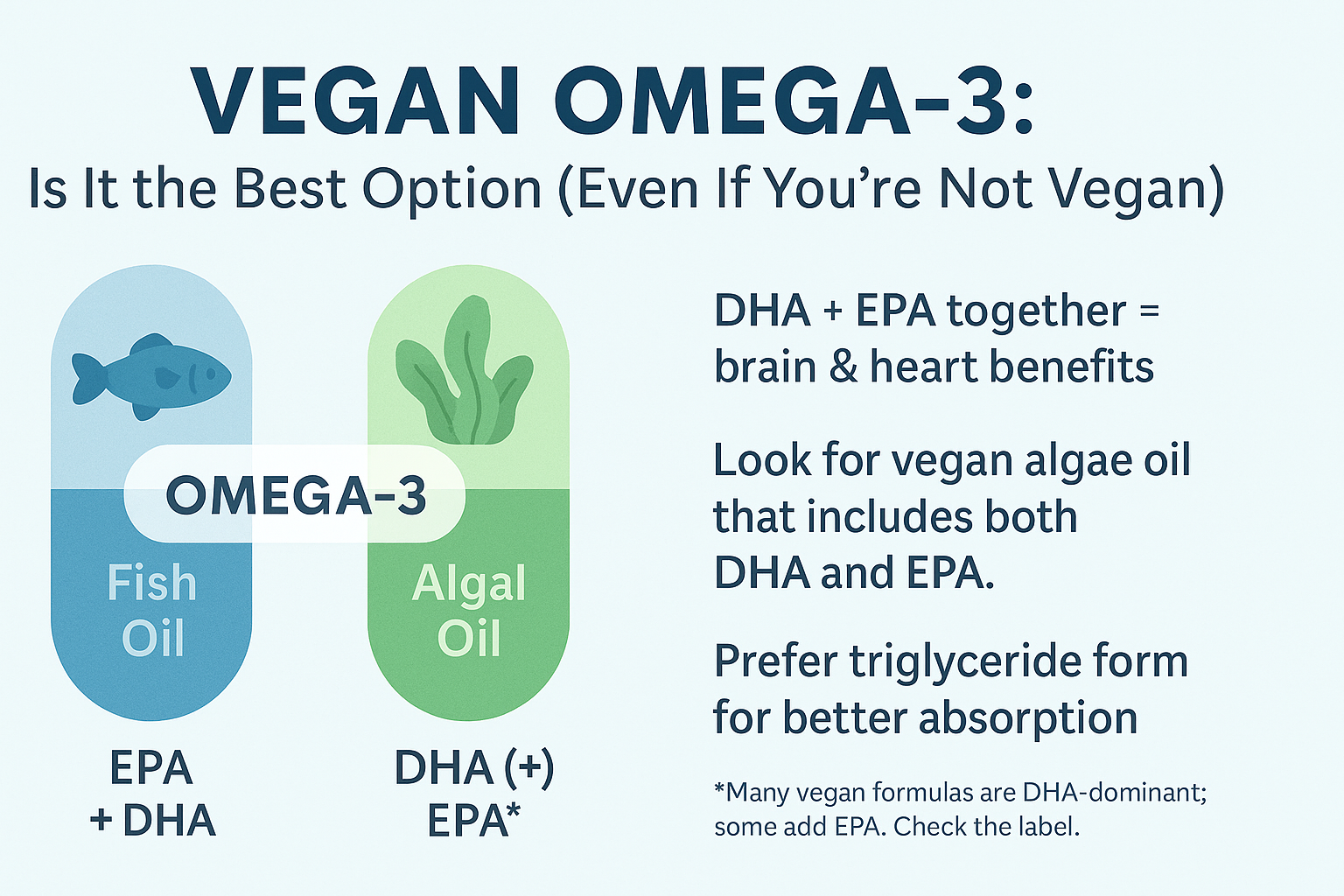Vegan Omega-3: Is It the Best Option (Even If You’re Not Vegan)?
Evidence review on algal DHA/EPA vs. fish oil
TL;DR: High-quality algal oil (vegan omega-3) raises blood DHA/EPA as effectively as fish oil in most studies, avoids marine contaminants, and is more sustainable. If you don’t eat fish—or prefer a cleaner, plant-origin source—algal DHA/EPA is an excellent choice.
What the research says
- Algal oil vs fish oil: similar efficacy. Randomized trials show algal-derived DHA/EPA raises blood omega-3 levels comparably to fish oil or cooked salmon [Arterburn et al., 2008].
- ALA (flax/chia) isn’t enough. The body converts only a small fraction of ALA to EPA/DHA [Gerster, 1996].
- Purity & sustainability. Food-grade algal oils are produced in closed fermentation—limiting exposure to contaminants like mercury/PCBs [USDA Tech Review, 2011].
When vegan omega-3 is a smart pick
- You rarely eat fatty fish or avoid fish products.
- You want a source with predictable purity and consistent DHA/EPA dosing.
- You’re pregnant, breastfeeding, or planning pregnancy and prefer a fish-free DHA source (always check dosing with your clinician).
- You care about sustainability or have fish/seafood allergies.
Practical takeaways
- DHA + EPA work best together: These two fatty acids deliver the main brain and heart benefits. Fish oils naturally include both, while vegan algal supplements are often DHA-dominant. Look for vegan formulas that also add EPA if you want a more balanced effect [Swanson et al., 2012].
- Triglyceride vs. ethyl ester: The triglyceride form of omega-3 is absorbed better than the ethyl ester form [Harris et al., 2010]. Many high-quality algal oils are triglyceride form, which can give them an absorption advantage over some lower-grade fish oils.
- Label check: Look for per-capsule DHA/EPA amounts (not just “omega-3”).
- Dose: Many adults target ~250–500 mg combined EPA+DHA daily (individual needs vary—ask your clinician).
- With meals: Take with food for better absorption and to minimize aftertaste.
- Quality: Prefer brands with third-party testing for potency and oxidation.
👉 Bottom line: If you eat fish and tolerate fish oil, high-quality triglyceride-form fish oils give a full spectrum of EPA+DHA. But if you’re vegan, allergic, or want a cleaner and more sustainable source, algal omega-3 in triglyceride form with both DHA and EPA is an equally strong choice.
References
- Arterburn LM et al. (2008). Algal-oil capsules and cooked salmon: nutritionally equivalent sources of DHA. J Acad Nutr Diet.
- Gerster H. (1996). Conversion of α-linolenic acid to EPA and DHA in humans. Am J Clin Nutr.
- Swanson D, Block R, Mousa SA. (2012). Omega-3 fatty acids EPA and DHA: Health benefits throughout life. Adv Nutr.
- Sneh Punia et al. (2019). Absorption and bioavailability of omega-3 fatty acids – A review. PharmaNutrition.
- Elsevier (2025). A comprehensive review on algae oil: Resources, production, encapsulation and application in food.

